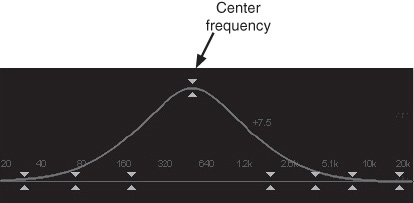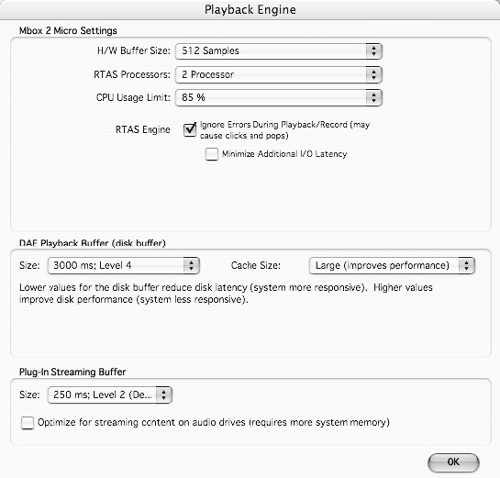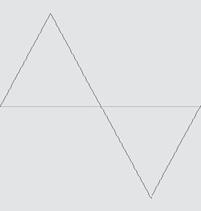cache. ![]() See cache RAM.
See cache RAM.
cache RAM. 1. Also known as L1 cache. A type of RAM (Random Access Memory) that is built into a computer’s microprocessor chip and operates at high speeds. Cache RAM is used to store frequently accessed data. 2. Also known as Level 2 cache, L2 cache. High-speed RAM that is often mounted to a computer’s motherboard, close to the CPU, and is used to speed the access to frequently used data and to transmit data from the processor chip to the main memory. 3. Also known as disk cache or hard drive cache. A type of RAM in a hard disk that is used to buffer data transfers. ![]() See also buffer.
See also buffer.
calibration microphone. A microphone that is intended for measurement purposes rather than recording or sound reinforcement applications. Calibration microphones typically have extremely flat response and are designed to provide an accurate, uncolored picture of the audio source.
cancellation. ![]() See phase cancellation.
See phase cancellation.
cans. ![]() See headphones.
See headphones.
capacitance. The capability of an electronic component to store a charge.
capacitor. An electronic component that stores an electrical charge. In audio, capacitors are also used as filters to separate high and low frequencies.
capstan. The motor-driven rotating shaft in a tape recorder that pulls the tape past the heads.
capsule (a.k.a. element). The capsule is the part of a microphone where sound is converted into electrical signals. The capsule contains the diaphragm, shock-mounting, windscreens and other protective elements, electronics, and other items.
capture. To record a sound source.
CARAS. Canadian Academy of Recording Arts and Sciences. A not-for-profit organization focused on the promotion of Canadian music and artists. CARAS puts on the Juno awards, the Canadian equivalent of the Grammys. www.carasonline.ca.
CardBus. A 32-bit version of the PC card standard. ![]() See also PC card.
See also PC card.
cardioid. A microphone polar pattern that is vaguely heart-shaped (see Figure C.1). Cardioid microphones are quite directional, picking up sound best from the front, less well from the sides, and not at all directly from the rear. Cardioid-patterned microphones are by far the most commonly used for studio and live applications because they can be positioned to reject sound from the rear, providing good isolation and feedback rejection. Cardioid microphones, like all directional microphones, are subject to proximity effect.
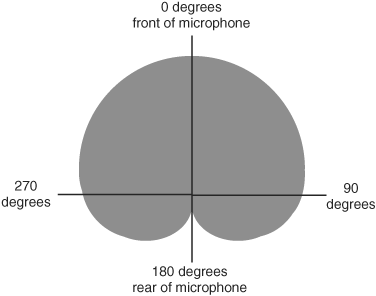
Figure C.1. A cardioid polar pattern is heart-shaped, picking up sound best from the front and rejecting sound from the rear.
carpet. A poor acoustical absorber best employed on the floor of a room to provide podiatric comfort.
carrier. In AM and FM synthesizers, the audible sound wave. The carrier is modulated by one or more other oscillators to create the desired waveform for a sound.
Cat 5. Short for Category 5. A type of twisted-pair cable used for Ethernet networks and other communication applications.
Cat 5e. Short for Enhanced Category 5. Cat 5e is an improved version of Cat 5 cable, with better crosstalk specs.
Cat 6. Short for Category 6. A very high-quality twisted-pair cable used for gigabit Ethernet and other high-speed communication applications.
CBR. ![]() See constant bit rate.
See constant bit rate.
CC. ![]() See continuous controller.
See continuous controller.
CCIR. Consultative Committee for International Radio. A standards organization that created many of the measurement standards used for audio equipment. The CCIR eventually became part of the United Nations’ ITU (International Telecommunication Union).
CC number. ![]() See continuous controller.
See continuous controller.
CD. ![]() See compact disc.
See compact disc.
CD Extra. (a.k.a. Enhanced CD, CD Plus). A compact disc format that combines both Red Book audio and Yellow Book computer data on the same disc. ![]() See also Blue Book.
See also Blue Book.
CD Plus. ![]() See CD Extra.
See CD Extra.
CD Text. An extended version of the Red Book CD spec that allows text data to be stored in the lead-in area of an audio disc. CD Text is used by some car CD players and other devices to display CD track names.
CD24. A 24-bit audio CD format developed by Alesis for use in the company’s MasterLink CD/hard drive recorder and intended for recording and playing high-resolution master recordings from compact disc media.
CDDA. Compact Disc Digital Audio. The “formal” name for standard audio compact discs. ![]() See also Red Book.
See also Red Book.
CDDB. Compact Disc Database. A trademark of Grace-note, Inc., CDDB is an online database that can be accessed by media players and CD ripping software for artist name, CD title, track list, and other information. CDDB was intended to solve the lack of track names and other information on standard audio CDs. The database identifies a CD using calculations based on the track duration information in the disc’s TOC.
CD+G. An extension of the audio compact disc specification that adds graphics content. CD+G discs will play in a standard audio CD player, or, when used in a CD+G-compatible player, will provide a graphics signal. CD+G discs are used for karaoke and other applications. ![]() See also Blue Book.
See also Blue Book.
CD-quality. Digital audio at 16-bit, 44.1-kHz resolution. The term CD-quality does not have any meaning regarding the actual quality of the audio; it simply specifies the sample rate and bit resolution.
CD-R. Compact Disc-Recordable. Orange Book optical media that can be recorded by end users. CD-R media uses a dye layer into which “pits” are burned by a laser to represent data. Once the disc has been written, it cannot be modified. Once burned, a CD-R becomes compatible with Red Book, Yellow Book, and other format optical media players.
CD-ROM. Compact Disc Read-Only Memory. Compact disc optical media that conforms to the Yellow Book standard. CD-ROMs are used to store computer data.
CD-RW. Compact Disc-Rewritable, a.k.a. CD Erasable. A version of CD-R media that uses an alloy recording layer that can be melted and rewritten. CD-RW discs are not as reflective as CD-R or CD media and do not meet Red Book or Orange Book specs, so some older players may not be able to read them.
ceiling. The highest level that a limiter will allow a signal to reach. In digital recording and mixdown, the ceiling is often set just below digital 0 to provide protection from “overs” and clipping.
cent. 1/100 of a semitone. Pitch and frequency do not have a linear relationship, but cents and pitch do; for this reason, it is often clearer to use cents to describe tuning and other pitch relationships.
center detent. A notch that indicates the center position in a potentiometer’s travel. Center detent pots are used for pan pots, boost/cut controls, and other applications.
center frequency. With a bell filter, the frequency to which the filter is set. Frequencies around the center frequency are also boosted or cut, creating the characteristic bell shape. See Figure C.2.
center section (a.k.a. master section). The part of a mixing console that contains all the “master” controls—subgroups, monitor controls, master aux sends and returns, master faders, and more. In larger consoles, the center section is in the middle of the channels, allowing easy access. On smaller consoles, the center section is often on the right side.
challenge/response. A type of copy protection in which the software is unlocked when the user inputs the correct answer to a question, or “challenge.” The response is typically a code that is keyed to one specific install of the software. The user obtains the response from the manufacturer after registering the software. The advantage to challenge/response systems is that no copy protection hardware (such as a dongle) is required. The disadvantage is that the software is useless if the user tries to install it and there is a problem getting the proper response—such as if the manufacturer has gone out of business.
channel. A signal path that deals with a single mono or stereo audio signal.
channel aftertouch. ![]() See monophonic aftertouch.
See monophonic aftertouch.
channel masking. In SP-MIDI, the process of a composer establishing the MIDI channel priorities for playback of a particular piece of music.
channel message. A category of MIDI messages that are sent over a specific MIDI channel and that are only intended for and only received by devices set to that MIDI channel.
channel pressure. ![]() See monophonic aftertouch.
See monophonic aftertouch.
channel separation. The amount of crosstalk or signal bleed between two channels. The higher the crosstalk, the lower the separation, and vice versa.
channel strip. 1. A single input channel of a mixing board. 2. A piece of outboard gear containing a microphone/line/instrument preamp, equalization, and sometimes compression, limiting, gating, deessing, and/or other processing. 3. A plug-in containing equalization and dynamics processing, such as compression, limiting, and gating. See Figure C.3.
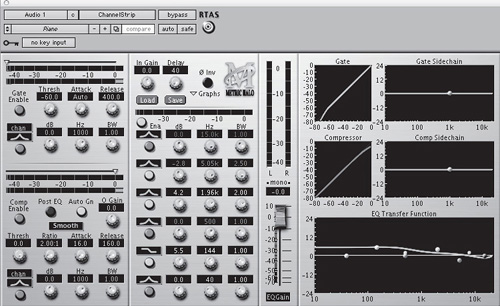
Figure C.3. A plug-in channel strip contains a variety of processing in a single unit, such as EQ and dynamics processing—in this case, gating, compression, and equalization. A hardware channel strip would add a microphone preamp to the list of capabilities.
chase. To synchronize or “slave” a device so that it locks to or follows a time-code master.
chatter. When a noise gate is presented with a signal level slightly above or below its threshold, the gate may rapidly jump back and forth between open and closed states, causing the audio to cut in and out, or chatter.
chip. Short for microchip. An integrated circuit made from a semiconductor material.
chipset. Literally, a group of chips that are designed to work together. In a computer, the chipset is a group of chips that defines the functions of the CPU and controls communications with external devices.
chorus. 1. A “refrain” or repeat of an important section of a song. 2. An audio effect created by processing a signal through a number of short modulated delays, then mixing the delayed versions with the original dry signal. The result is a thick, rich sound with a lot of motion that simulates a number of voices or instruments simultaneously performing a part. A chorus-style effect can also be created by slightly pitch-shifting a signal, then combining the shifted version or versions with the dry signal.
CIRC. Cross-Interleaved Reed-Solomon Code. An error-correction scheme used in compact disc players. CIRC adds one parity bit to every three data bytes. This is sufficient to correct scratches up to 8.5 mm long in a CD surface.
circuit breaker. A reset-able safety device, similar to a fuse, used to protect electrical circuits from overload. A circuit breaker automatically flips open when the current in a circuit exceeds a specific maximum amount.
circumaural. Headphone ear cups that circle around the ears and rest on the sides of the head of the wearer. Most circumaural headphones are closed designs that provide good isolation from external sound getting into, and internal sound getting out of, the headphones.
class. A type of amplifier design that determines how the sections of an amp handle current flow. There are several types:
Class A. A type of amp in which current flows all the time, whether it is a single-ended or push-pull design. Because current is always flowing, the amp responds very quickly to input signals, and crossover distortion is reduced. True Class A amps are expensive and inefficient to operate.
Class AB. A type of amp that operates in Class A for part of the time and Class B for the remainder. Class AB is the most common class of amplifier; it offers good efficiency and response time that falls between Class A and Class B.
Class B. A type of amp in which current only flows when there is input signal present. Because current must start to flow when signal appears, the amp has a slower slew rate and increased crossover distortion. However, Class B amps are inexpensive and efficient to operate.
Class D. A type of amp in which the input signal is used to modulate an ultrasonic square wave, which is then low-pass filtered to create the amplifier’s output signal, which is driven using a push-pull, or switching, output design. Class D amps are highly efficient and lightweight, making them ideal for battery-powered and portable applications. (Note: “D” does not stand for digital. Class D amplifiers are analog designs, with no digital encoding of the signal.)
Class G. A type of Class AB amplifier that uses multiple power rails with different voltages on each. Whichever rail is closest in voltage to the output signal is used, making the amp very efficient and lightweight. The disadvantage is increased distortion when the output signal falls between the rails.
Class H. A Class G amplifier with modulated power-rail voltages, so that the rail is always within a few volts of the output signal, making the amp extremely efficient.
class compliant. A USB device that uses the “generic” MIDI or other drivers that are built into a computer’s operating system and does not require proprietary drivers in order to function.
clean. The opposite of dirty. A signal that does not contain noise, distortion, or other undesirable artifacts.
click. ![]() See tick.
See tick.
click and hold. A computer mouse technique in which the mouse pointer is positioned over an icon or file name, and the mouse button is pressed (clicked) and held down. Typically, this action is followed by dragging the icon or file while keeping the mouse button held down.
click track. A MIDI or audio track that provides a metronome-style “click” or percussion sound that serves as a tempo guide for recording the other parts in a piece of music.
clip. 1. To cut or delete data from a document or track. 2. Term used by some manufacturers for a region or segment of audio or MIDI data within a track.
clipboard. A memory space in a computer where data that has been cut or copied out of a document or file is temporarily stored. Typically, a clipboard only holds information from a particular program. This information can be retrieved and placed back into a document or file using the Paste command. When that program is shut down, the clipboard memory is emptied. Clipboard contents are lost when the computer’s power is turned off as well.
clipper. A module in a synthesizer that clips or distorts the signal, producing a great deal of additional harmonic content.
clipping. A type of distortion that results from a signal’s level or voltage being higher than an analog circuit’s electronics can reproduce accurately or a digital converter can represent. The signal above the circuit’s maximum level is literally clipped, or squared off, resulting in a great deal of harmonic distortion. In extreme cases, the clipped waveform will resemble a square wave. At very low levels, carefully controlled clipping distortion can be used to enhance signals, adding brightness and intelligibility. See Figure C.4.
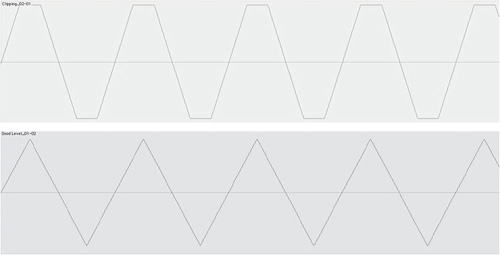
Figure C.4. Clipping occurs when a signal exceeds the maximum level that a circuit can pass without overloading. Higher levels will result in the top of the waveform being squared off and distorted (bottom).
clock. A timing reference used in digital circuits to specify a given number of cycles or operations in a period of time.
clock speed. The rate at which a clock operates, which drives how fast operations occur in a digital device.
close field. ![]() See near field.
See near field.
close miking. Recording with a microphone placed very close to the source—from a fraction of an inch to a foot or so away. The advantage to close miking is that the microphone picks up only a very small amount of room ambience. (If the source is loud enough, essentially zero ambience will be captured.) Through careful placement, the proximity effect of directional mics can also be put to use for thickening a sound.
closed ear. A type of headphone with ear cups that are sealed to increase isolation from external sound entering the phones or internal sound escaping into the room.
cloud. Acoustical device suspended from the ceiling over the listening position to reduce first reflections. A cloud may be either an absorber or, in cases where the ceiling height is tall enough, a diffusor.
CLV. Constant Linear Velocity. A rotating disc moves at a different speed at the inside of the disc than at the outside. A CLV system speeds up or slows down the rotating speed of the disc so that surface velocity at any given point on the disc is moving at the proper rate as it passes a read or write head. All types of CD and DVD drives and players use the CLV approach.
CMOS. Complementary Metal Oxide Semiconductor or Complementary-Symmetry Metal Oxide Semiconductor. A type of low-power, low-heat integrated circuit commonly found in computers and other devices. CMOS chips are especially useful for battery-powered applications. For example, battery-powered CMOS chips are used in many computers to store the date, time, and system configuration.
CMR. ![]() See Common Mode Rejection.
See Common Mode Rejection.
CMRR. Common Mode Rejection Ratio. A specification that indicates the amount of cancellation that will occur at the input of a balanced system. ![]() See Common Mode Rejection.
See Common Mode Rejection.
coarse. The opposite of fine. Coarse refers to large increments of change or measurement, usually in reference to a control or parameter movement.
coaxial. A cable, speaker, or other item where two or more parts share the same center point. In a coaxial speaker, the high-frequency driver is mounted in the center of the low-frequency driver. In a coaxial cable, one insulated conductor runs through the center of another conductor. (Typically, the outer conductor is a grounded shield, and the inner conductor carries the signal.)
code. 1. A representation of information that must be translated or decoded to be understood. 2. Computer instructions or programming.
CODEC. Coder/Decoder or Compressor/Decompressor. A software algorithm or hardware component that encodes and decodes signals or information to, for example, create digital audio from analog audio (and vice versa), or MP3 files or other formats.
coercivity. A specification defining a particle’s tendency to stay magnetized. Coercivity is an important spec for all magnetic media, such as analog recording tape, hard drive platters, and more.
coil. ![]() See inductor.
See inductor.
coincident pair. (a.k.a. XY). A stereo miking technique in which two microphones are placed so that their diaphragms are as close to in the same place as possible, usually by mounting one above the other (see Figure C.5). Cardioid-pattern mics are usually used, though other polar patterns could be used as well. The width of the stereo image can be controlled by the angle between the microphone capsules. ![]() See also XY stereo, mid-side stereo, Blumlein pair.
See also XY stereo, mid-side stereo, Blumlein pair.
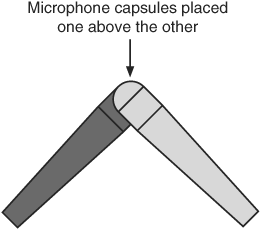
Figure C.5. Coincident microphones are placed so their diaphragms are as close together as possible.
collapse. 1. To make a track or lane in a DAW smaller. 2. To close a program window.
coloration. Change in the timbre of a sound or signal.
com port. An input or output connection on a PC that is used for connecting external peripheral devices.
comb filter. A type of device that produces comb-filtering effects.
comb filtering. A type of cancellation or filtering effect that causes a series of deep notches and peaks in frequency response, usually due to phase differences between sound waves. Comb filtering results in significant coloration of the sound. Comb filtering can be used as an effect, as in a phase shifter. Acoustical comb filtering, resulting from sound wave interactions in a room, can be problematic for making accurate recording or mix decisions.
combi. In some synthesizer workstations, a combi is a complete multitimbral setup, with all presets, MIDI channels, effects settings, and more.
combi mode. Term used by some manufacturers for the multitimbral mode in their synthesizers.
combination. ![]() See combi.
See combi.
combination tone. ![]() See sum tone, difference tone.
See sum tone, difference tone.
combo jack. A type of connector that can accept either XLR or 1/4-inch connectors.
Common Mode Rejection (a.k.a. CMR). A technique used in signal transmission, in which two versions of a signal—one “normal” and the other with reverse polarity—are sent down two conductors in a cable. When the signals reach their destination, the polarity-reversed version is flipped to normal polarity and added to the non-polarity-reversed version. Reversing the polarity at the destination cancels out anything that was common to the two conductors, such as noise that was picked up during transmission. ![]() See also balanced.
See also balanced.
comp. 1. Short for “composite.” A technique for creating a track from the best parts of several different performances recorded to other real or virtual tracks. ![]() See also composite track. 2. Short for “accompaniment,” typically playing rhythmic chords behind a solo or vocal.
See also composite track. 2. Short for “accompaniment,” typically playing rhythmic chords behind a solo or vocal.
compact disc (a.k.a. CD). A 120 mm (4.75-inch) optical media. Compact discs are read by lasers that follow a spiral track of pits in the sublayers of the disc. The discs are read from the inside to the outside; the disc rotates at 500 RPM when reading the inside part of the disc, and slows to 200 RPM as the laser reaches the outside of the disc. A variety of standards exist for using and formatting compact disc media, which are gathered into the Rainbow Books, a set of colored volumes, each of which contains the specification for a different standard. ![]() See also CLV.
See also CLV.
CompactFlash (a.k.a. CF). A standardized data storage card type with no moving parts that was first introduced in 1994. CompactFlash cards use flash memory and have capacities ranging from 2 MB to 64 GB or higher. There are two categories, Type I and Type II, which are of different thicknesses (3.3 mm and 5 mm, respectively). There are four speeds: CompactFlash, CompactFlash High Speed, CompactFlash 3.0, and CompactFlash 4.0. CompactFlash cards retain their memory even when they are removed from a card slot or the power is interrupted.
companding. Compression/expansion. A noise-reduction technique in which the input signal is compressed before it is recorded or processed, and then expanded on playback or output. As the signal is expanded, any noise that has been added in recording or processing is pushed down and made less audible.
composite track. A track created by combining sections of several other tracks (see Figure C.6). ![]() See also comp.
See also comp.
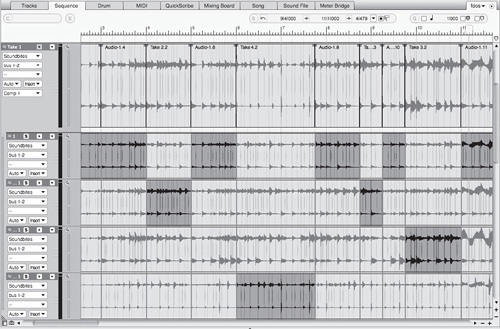
Figure C.6. Comping is the process of combining the best parts of two or more tracks to make a new composite track. In this example, the top track is the “comp,” which has been created using the best parts of the four takes below.
compression. 1. An area of increased pressure caused by a sound wave; the opposite of a rarefaction. 2. Processing that reduces the dynamic range of an audio signal. ![]() See also compressor. 3. The process of reducing the size of a data file to save storage space or to allow for transmission to another device.
See also compressor. 3. The process of reducing the size of a data file to save storage space or to allow for transmission to another device. ![]() See also data compression.
See also data compression.
compression driver. A small speaker driver that mounts to the “throat” or small end of a horn. The driver produces the sound waves at high sound pressure levels, while the horn provides dispersion.
compressor. A device or plug-in that reduces the dynamic range of a signal. A threshold level is set. When a signal level rises above the threshold, the signal level or gain is reduced by an amount defined by a ratio setting. The ratio determines how much the output signal is allowed to rise in level versus the input level. For example, a 2:1 ratio would allow the output to increase by one decibel for every two decibels the input level increases. A 5:1 ratio would allow the output to increase by one decibel for every five decibels the input level increases. Other controls determine how fast the compressor operates on a signal after it has crossed the threshold (attack) and how fast the compressor lets go of the signal after it drops back below the threshold (release). See Figure C.7.
compressor/limiter. A dynamics processor that can function as either a compressor or a limiter. The difference is how the parameters are set. The most important difference is the ratio, which is 10:1 or higher for limiting and less than 10:1 for compression.
concert pitch. An instrument-tuning standard that is referenced against the note A above middle C equaling 440 Hz.
condenser. ![]() See capacitor.
See capacitor.
condenser microphone. A type of microphone that uses a thin metal or metal-coated diaphragm that is positioned very close to a backplate. Together, the diaphragm and backplate form a capacitor that is either permanently charged or charged using an external voltage, such as phantom power. The diaphragm moves in response to sound waves, causing the distance to the backplate to vary and changing the capacitance and creating the output signal.
conductor. A material that will carry or transfer electrical current.
conductor track. A track in a DAW or sequencer that is used to hold a tempo map. Some DAWs or sequencers also store time signature and key changes in a conductor track.
cone tweeter. A type of high-frequency driver composed of a voice coil (typically 3/4-inch) suspended in a magnetic field that moves a small, light cone to create sound waves. Various materials are used for the cone, including ceramic, paper, treated fabric, stiffened silk fabric, and more. Cone tweeters are inexpensive but do not disperse sound as well as some other types, such as dome tweeters.
confidence monitoring. A system used in tape recorders (analog and digital) in which a separate playback head is placed after the record head to play back the audio a fraction of a second after it was recorded. This allows the engineer to hear exactly how the audio is being recorded. ![]() See also repro.
See also repro.
configuration. An arrangement or setup of components or devices in a system.
conform. To edit a sound-track to fit a film or video.
console. ![]() See mixing console.
See mixing console.
constant bit rate (a.k.a. CBR). Audio data compression algorithms that do not change bit rate regardless of the complexity of the input signal. The same bit rate is used for simple audio material as is used for complex material. In some cases, this rate may be too low to adequately represent the audio; in other cases, it may be too high, resulting in wasted space. Constant bit rates are better for transmitting data over a limited-bandwidth connection, as the rate can be set to stay below the maximum. For maximizing compressed file storage efficiency, variable bit rate algorithms (VBR) are often the better choice.
Constant Directivity. A trademarked term for a type of speaker horn that has equal SPL at all frequencies over the range of angles the horn is designed to address.
constant Q. In most equalizers, when a band is pushed up or pulled down, as the center frequency is boosted or cut, other frequencies around the center frequency are also boosted or cut. The more the center frequency is boosted or cut, the wider the band of frequencies that is affected, potentially causing interaction between adjacent bands. A constant Q design maintains the same bandwidth of affected frequencies no matter how much the center frequency is boosted or cut, preventing interaction between bands and allowing finer control. See Figure C.8.

Figure C.8. A constant Q equalizer maintains the same bandwidth for each band, no matter how much boost or cut is applied.
consumer. Products intended for the general public. In audio, “consumer” generally refers to home stereo and home theater equipment, as well as keyboards, digital pianos, and other products aimed at home use. ![]() See also semi-pro, professional.
See also semi-pro, professional.
contact microphone (a.k.a. piezo microphone, transducer microphone). A microphone that creates electrical signals in response to mechanical vibrations carried through physical contact rather than sound waves carried through the air.
contact pressure. The amount of pressure headphone ear cups place on the sides of the wearer’s head. Closed ear headphones typically have higher pressure to ensure a tighter seal. There actually is a DIN standard (Standard 45500 Part 10) for how much pressure headphones can exert.
content. The material that makes up an artistic work or production.
contextual menu. A computer menu that pops up or opens when an icon or other item is selected with a right-hand mouse button or by a combination of a modifier key and a mouse click. The options presented in a contextual menu will change depending on what is appropriate or possible for the item selected.
Continue. A MIDI System Real Time message that tells a sequencer to begin or resume play from its current location.
continuity. An unbroken signal path.
continuous controller. ![]() See MIDI continuous controller.
See MIDI continuous controller.
control panel. A small piece of software that provides setup options for, and control over certain aspects of, the operation of a peripheral device, program, or computer. See Figure C.9.
control room. The part of a studio where the recording and processing gear lives and the engineer and producer run sessions. Typically, the control room is acoustically isolated from the actual “studio” or live room or isolation booths where microphones are used to capture performances and sounds, though in many studios, the control room is also used for miking instruments and vocals and capturing sounds.
control surface. At its most basic, a control surface is a hardware “remote control” that provides manual access to functions, parameters, and settings within a piece of software. Control surfaces may resemble mixing consoles, but no audio runs through a control surface. Rather, the faders, knobs, and switches send out MIDI, OSC, or proprietary commands that are received by the computer and software. (In some cases, a control surface may have some monitor control and other audio capabilities built in.)
control voltage (a.k.a. CV). An electrical signal that is used to change the parameters in an analog circuit. Control voltages are commonly used in analog synthesizer modules, such as voltage-controlled oscillators, voltage-controlled filters, and voltage-controlled amplifiers, as well as in some effects pedals and VCA-based mixer automation systems.
Controller. ![]() See continuous controller.
See continuous controller.
controller keyboard. (a.k.a. keyboard controller, master controller, controller) A keyboard that usually does not contain any synthesis, sampling, or sound-generation ability, but is used as a MIDI controller that provides note and control information for MIDI software and hardware instruments. In addition to standard keyboard keys, a controller keyboard may provide sliders, knobs, and switches that can be “mapped” or assigned to control certain functions in the receiving devices. Controller keyboards are available in 25-, 37-, 49-, 61-, 76-, and 88-key lengths. In some cases a standard synthesizer or workstation keyboard can be used as a controller keyboard, or a synth expansion card can be added to certain controller keyboards to add sound-generation capabilities. Older controller keyboards are connected via MIDI cables, while modern units can often be connected directly to a computer using USB.
conversion latency. The amount of time (generally a millisecond or two) it takes for a signal to enter an A/D or D/A converter and to emerge from the output after being converted.
converter. In audio, a device that converts analog signals to digital or digital signals to analog.
convolution. A digital audio process where one signal is used to modify a second signal. Mathematically, convolution is multiplying the first signal by the second signal in the frequency domain, creating a sort of filter. For example, with convolution reverb, an impulse—a sound file created by recording the reverb sound of a room—might be used to process another waveform, making it sound like the second sound was recorded in the ambience of the first room’s reverb. Although creating realistic reverb effects is the most common use for convolution, any sound can be used to modify another sound. For example, a guitar speaker cabinet’s response might be used to process a direct guitar sound. Or, the response of a specific microphone type might be used to change the tonality of a vocal—the possibilities are extensive.
convolution reverb. A type of reverb effect in which the reverb sound of a real room is used to process other sounds, creating very realistic spaces. ![]() See also convolution.
See also convolution.
copy. 1. To make a duplicate of an item for backup, archival, or to be used for some other purpose. 2. A computer command that makes a duplicate of selected data and stores it to the clipboard.
copy protection. A hardware device or software code that is designed to prevent unauthorized copying or distribution of copyrighted software or other intellectual property.
Core. An Intel brand of computer processors. Multiple Core (multi-core) processors can be combined on a single chip (called a die), resulting in Core Duo and other processors. The first Core processors were intended for notebooks; later Core 2 processors were aimed at desktops and laptops. Several types have been created, some with multiple processors:
Core Duo. A die containing dual computational cores and 2 MB of shared Level 2 cache.
Core 2. A later version of Intel’s Core processors, with 64-bit processing support.
Core 2 Duo. Core 2 processor with dual computational cores and 4 MB of shared Level 2 cache.
Core Audio. 1. The audio subsystems developed by Apple for the Macintosh OS X operating system. Core Audio is designed to remove the responsibility for creating audio protocols from third-party software developers and provide a standard that those developers can access and build upon. Core Audio handles communication between the system and audio programs, with support for multiple channels and high-resolution audio. 2. Microsoft term for the audio protocols that are used in Windows Vista. ![]() See Vista Core Audio.
See Vista Core Audio.
Core MIDI. The built-in MIDI protocols in Apple’s Macintosh OS X operating system. Core MIDI is designed to remove the responsibility for creating MIDI protocols from third-party software developers and provide a standard that those developers can access and build upon. Core MIDI handles communication between the system and MIDI programs.
corner. The worst place to put a studio monitor. Placing a speaker in a corner, or half-space, causes a 6-dB boost in low frequencies, making the sound inaccurate.
corner frequency. ![]() See 3 dB down point.
See 3 dB down point.
corrupt/corruption. A file, disc, or storage media that contains catastrophic errors.
COSM. Composite Object Sound Modeling. A modeling technology, developed by Roland, designed to emulate microphones, amplifiers, pickups, and a variety of other types of equipment and processing. COSM has been used in Roland’s keyboards, guitar and effects processors, standalone digital recorders/mixers, and more.
couch. Marginally effective acoustic absorber well suited to supporting the posterior regions of humans.
count in. A bar or two of metronome, click track, or counting before a song starts that is used to establish the tempo and when the song should start. When used for a studio recording, the count in is muted or edited out of the track after the recording is completed.
count off. ![]() See count in.
See count in.
counter. A display on a recorder or in a DAW or other audio software that indicates the current time position in the song. The time may be indicated in musical bars and beats, real time, time code, or samples. See Figure C.10.
Figure C.10. A counter in a recorder or piece of audio software that indicates the time position in a song. The time may be displayed in a variety of formats.
coupling. 1. An audio source, such as a studio monitor, transmitting vibrations into another item, such as a desk on which it is resting. Decoupling, or isolating, monitors or other items helps maintain the accuracy of the sound. 2. Various methods for connecting electronic circuits.
CPU. Central Processing Unit. A CPU is the microprocessor “brain” in a computer that controls all operations and functions.
crash. A condition in which a computer program or part of the operating system suffers an error or catastrophic event and stops functioning.
CRC. Cyclic Redundancy Code or Cyclic Redundancy Check. A type of error correction that uses a code derived from a block of data to verify the accuracy of a transmission.
CRIA. Canadian Recording Industry Association. The CRIA is an organization that develops standards and works to improve the Canadian recording industry. www.cria.ca.
critical band. In psychoacoustics, the band of frequencies that will mask a given signal.
critical distance. In acoustics, the distance at which the level of a sound source equals the level of reflections from surrounding surfaces.
cross modulation. A function of some synthesizers where an oscillator can be used to modulate another oscillator.
cross platform. A piece of hardware or software that is compatible with both Windows PC and Macintosh computers.
cross switch. A synthesis and sample programming technique in which different key velocities are used to switch between synth patches or samples. A low velocity might play one program, a medium velocity a second program, and high velocities a third. In sampling, cross switching is often used to switch between multisamples. A sound is sampled at a number of volume levels, then low velocities are assigned to trigger soft samples, medium velocities play medium volume samples, and high velocities play the loud samples. In some instances, cross switching may be assigned to trigger in response to some other controller, such as a footswitch or mod wheel. See Figure C.11.

Figure C.11. The cross-switch function in synthesizers and samplers is used to trigger different programs or samples based on velocity values. In this case, a separate sample has been assigned to each of the key zones, and different samples are played for the zones based on the velocity of the key strikes.
crossfade. 1. An audio editing technique in which one region of audio in a track fades out while a subsequent region of audio fades in. Long crossfades are used to gradually transition between audio regions. Very short crossfades—so short as to be virtually inaudible—are used to smooth over click and pop sounds that can result from splicing two audio regions together. 2. A synth/sampler programming technique similar to cross switching, where different key velocities are used to switch between synth patches or samples. The difference is that the crossfade technique has a smooth transition between samples or synth sounds instead of an abrupt switch between sounds or samples. 3. A DJ technique, now used in a variety of applications, in which a slider control is used to smoothly fade one track out while another track is faded in.
crossover. A device that splits full-range audio into two or more independent frequency ranges. In sound reinforcement or other amplification/speaker applications, this allows, for example, the bass frequencies to be routed to their own amp and speaker, the midrange to be sent to its own amp and speaker, and so on. A crossover may also be used to split the audio range so that the separate frequency ranges can be processed independently. Heavy compression might be applied to bass frequencies, light compression to the high frequencies, and no compression on the midrange. See Figure C.12.

Figure C.12. A crossover splits full-range audio into two or more frequency bands so those bands can be amplified or processed separately.
crossover cable. Ethernet cables are usually wired so that a hub is required for proper communication. Without a hub, the connections end up reversed at one end. A crossover cable is an Ethernet cable specifically designed to be used to directly connect two devices together without using a hub or switcher.
crossover distortion. A type of distortion that is most prevalent in push-pull amplifier designs, where separate transistors or tubes are used to amplify the positive and negative portions of a waveform. Crossover distortion occurs at the transition point between the positive and negative components.
crossover frequency. The frequency or frequencies at which a crossover divides a full-range audio signal into two or more separate frequency bands.
crossover point. ![]() See crossover frequency.
See crossover frequency.
crosstalk. Signal that “bleeds” or leaks through from one signal path to another.
CRT. Cathode Ray Tube. A video display technology used in televisions and computer monitors in which an electron beam “gun” moves across the inside of the screen, lighting up phosphor dots to create the picture. Lighter weight, more compact LCD, LED, and plasma screens have replaced CRT displays for most applications.
CS update. Customer Service Update. An interim software update between numbered versions of a program that addresses bugs and minor problems.
Csound. A free cross-platform audio programming language, based on the C computer programming language, designed for synthesis and sound processing. A piece of music in Csound uses two files—an orchestra file, which defines the sounds used, and a score file, which defines the notes and performance parameters.
cube. The worst possible shape for a recording or monitor space, with all the walls and the ceiling and floor configured as squares of equal dimensions. Since all three dimensions (height, length, width) in a cube are identical, the acoustic mode resulting from that dimension will be substantially worse than if the dimensions were different.
cue. 1. An indication to musicians when a particular musical event or gesture should take place. 2. A piece of music composed for a specific film scene. 3. To position a tape recorder, DAW, or LP to begin play at a specific point.
cue list (a.k.a. cue sheet). A listing of what happens when during a piece of music or a film. A cue list is often referenced against time code, though other time formats may be used in a DAW.
cue mix (a.k.a. monitor mix). A headphone mix sent to musicians during recording so they can monitor other musicians and tracks.
cue sheet. ![]() See cue list.
See cue list.
current. The flow of electricity produced by voltage, measured in amps.
current limiting. A protection function in some power amplifiers that prevents too much current from flowing if the load impedance drops too low. Current limiting controls the current without shutting it off completely, as a fuse would.
cursor. A position indicator on a screen usually controlled by a mouse in GUI operating systems. The cursor shows where user input will take place, such as a mouse click, text entry, an edit point, and so on.
cut. 1. A song or track. 2 The process of recording tracks. 3. A computer command that deletes selected data and stores it to the clipboard.
cutoff frequency. The point at which the response of a filter is 3 dB below the passband or un-attenuated level. ![]() See also 3 dB down point.
See also 3 dB down point.
cut-only equalizer. A graphic equalizer that is only able to attenuate the level of frequencies and is unable to boost frequencies. The signal passes un-attenuated when the sliders are all the way at the top of their travel. Many cut-only EQs are passive devices. Some engineers prefer using cut-only equal-izers—or using a regular equalizer only for cutting frequencies—in order to preserve headroom.
C-weighting. Using a flat-response, limited-bandwidth filter to obtain measurements that correlate better with how our ears hear.
cycle. One repetition of the positive and negative states or peak and trough regions of a waveform. See Figure C.13.
cycles per second (a.k.a. frequency, Hertz). Number of complete peak/trough cycles in a sound wave that occur in a second.

